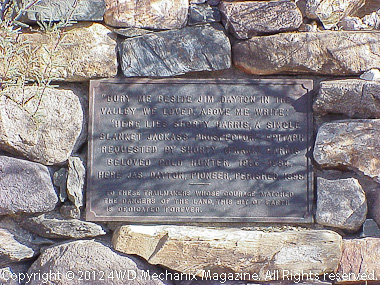Tom Willis lives at northern Nevada. Tom has been involved in all aspects of Off Highway Vehicle (OHV) activities for the past 40 years. He has written and published three guidebooks, covering off-pavement travel and activities in the Nevada and California deserts. Over the last eight years alone, Tom Willis has traveled more than 10,000 miles off pavement. Much of that travel has been research for his popular books.
Tom notes that people have been exploring the Far West for almost 250 years, and virtually any place worth visiting has an established trail access! Dedicated to the principles of Tread Lightly, Tom Willis encourages folks to take plenty of pictures and leave only tire tracks on existing trails. When a destination does involve a short walk, Tom suggests that exercise will probably do us all some good!
Tom Willis’ contributions to this corner of the magazine are about places to see, trails to drive and developments that affect OHV recreation in the western United States. His trail-based articles are destination oriented or “loop” trips, and Tom often talks about things you should know to make your explorations more enjoyable!

Inscription on this gravesite reads, “Bury me beside Jim Dayton in the valley we loved. Above me write: ‘Here lies Shorty Harris, a single blanket jackass prospector’…”
Death Valley National Park—West Side Road to Butte Valley!
Tom Willis, August 24, 2012—This is the first segment of a trip that will be described in two consecutive articles. The complete route begins in Death Valley and concludes at the southern edge of PanamintValley. Be sure to check road conditions with the Park Service at Furnace Creek.
The southern end of the Panamint Mountains, in Death Valley National Park, is rich in mining history. Some of it for gold, silver and lead mines, more often for talc mining.
I recommend that anyone taking this trip obtain a copy of either Tom Harrison’s “Recreation Map of Death Valley National Park” or the Trails Illustrated map of “Death Valley National Park.” A high clearance 4-wheel drive vehicle is a must, and at least two vehicles should make the trip. Stock SUV models might suffer some body damage.
Start at West Side Road, about 7 miles south of Furnace Creek Ranch, a well graded road with many historic points of interest along the way. This road was originally used by the 20 mule team borax “trains” on their way to and from Harmony Borax Works. There are a number of roads heading west into the Panamint Mountains, but only one provides a route through to Panamint Valley.
Along West Side Road, a few of the historical sites are the Dayton-Harris Grave, Eagle Borax Works, and Bennett-Arcane Long Camp. The latter is where the Bennett and Arcane wagon party spent December 1849. This camp is where Manly and Rodgers started their hike to get help at what today is Santa Clarita near Los Angeles, California.
Warm Springs Canyon Road is about 33 miles south from where you left the pavement—turn west here. This road is usually well maintained up to the Warm Springs Mine area, about 11 miles west from West Side Road.
The Park Service has removed the house, shop and swimming pool at Warm Springs. This was the residence of the mine manager. The structures have been replaced with a new (2012) “museum” to provide information about the history, mining and geology of the area. Most of the surrounding area is being returned to a natural state. It’s well worth a stop here. In the 1970s, mining here and in Galena Canyon accounted for 90% of California’s talc production.
The large mine entrance, with the heavy iron gate on a shelf near the south side of the road, is the White Point workings of the Grantham (Big Talc) Mine complex. Ownership of the mines and surrounding area was transferred to the National Park Service in the 1980s.

Geologist’s Cabin, photo by Tom Willis
Proceeding from Warm Springs to Butte Valley is limited to high clearance vehicles. There are a few trails in this valley, and our route takes us to the south end of Butte Valley. A great stopping point is Geologist’s Cabin, 11 miles from Warm Springs. This is a very nice one room stone structure, complete with a cement floor and intact windows. Be sure to sign the informal log book in the cabin. This cabin was built in 1930 by Asa Russell, a.k.a. “Panamint Russ”. The water source near the cabin is Anvil Spring.
Note: My next column/article will conclude this trip with a ride through Goler Wash to Panamint Valley…

